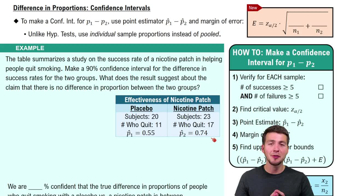Dogs Detecting Malaria The following table lists results from an experiment designed to test the ability of dogs to use their extraordinary sense of smell to detect malaria in samples of children’s socks (based on data presented at an annual meeting of the American Society of Tropical Medicine, by principal investigator Steve Lindsay). Assuming that the dog being correct is independent of whether malaria is present, find the expected value for the observed frequency of 123.
Table of contents
- 1. Intro to Stats and Collecting Data1h 14m
- 2. Describing Data with Tables and Graphs1h 55m
- 3. Describing Data Numerically2h 5m
- 4. Probability2h 16m
- 5. Binomial Distribution & Discrete Random Variables3h 6m
- 6. Normal Distribution and Continuous Random Variables2h 11m
- 7. Sampling Distributions & Confidence Intervals: Mean3h 23m
- Sampling Distribution of the Sample Mean and Central Limit Theorem19m
- Distribution of Sample Mean - Excel23m
- Introduction to Confidence Intervals15m
- Confidence Intervals for Population Mean1h 18m
- Determining the Minimum Sample Size Required12m
- Finding Probabilities and T Critical Values - Excel28m
- Confidence Intervals for Population Means - Excel25m
- 8. Sampling Distributions & Confidence Intervals: Proportion1h 12m
- 9. Hypothesis Testing for One Sample3h 29m
- 10. Hypothesis Testing for Two Samples4h 50m
- Two Proportions1h 13m
- Two Proportions Hypothesis Test - Excel28m
- Two Means - Unknown, Unequal Variance1h 3m
- Two Means - Unknown Variances Hypothesis Test - Excel12m
- Two Means - Unknown, Equal Variance15m
- Two Means - Unknown, Equal Variances Hypothesis Test - Excel9m
- Two Means - Known Variance12m
- Two Means - Sigma Known Hypothesis Test - Excel21m
- Two Means - Matched Pairs (Dependent Samples)42m
- Matched Pairs Hypothesis Test - Excel12m
- 11. Correlation1h 6m
- 12. Regression1h 50m
- 13. Chi-Square Tests & Goodness of Fit1h 57m
- 14. ANOVA1h 57m
9. Hypothesis Testing for One Sample
Steps in Hypothesis Testing
Problem 9.QQ.2
Textbook Question
Test Values p_cap1, p_cap2. Find the values of and the pooled proportion p_bar obtained when testing the claim given in Exercise 1.
 Verified step by step guidance
Verified step by step guidance1
Identify the sample proportions \( \hat{p}_1 \) and \( \hat{p}_2 \) from the problem statement or data provided. These represent the proportions of successes in the two samples.
Determine the sample sizes \( n_1 \) and \( n_2 \) for the two groups. These are the total number of observations in each sample.
Calculate the pooled proportion \( \bar{p} \) using the formula: \( \bar{p} = \frac{x_1 + x_2}{n_1 + n_2} \), where \( x_1 = \hat{p}_1 \cdot n_1 \) and \( x_2 = \hat{p}_2 \cdot n_2 \).
Substitute the values of \( x_1 \), \( x_2 \), \( n_1 \), and \( n_2 \) into the formula to compute \( \bar{p} \).
Use the pooled proportion \( \bar{p} \) in further hypothesis testing or calculations as required by the problem.
 Verified video answer for a similar problem:
Verified video answer for a similar problem:This video solution was recommended by our tutors as helpful for the problem above
Video duration:
2mPlay a video:
Was this helpful?
Key Concepts
Here are the essential concepts you must grasp in order to answer the question correctly.
Pooled Proportion
The pooled proportion, denoted as p_bar, is a weighted average of two sample proportions used in hypothesis testing. It combines the successes and failures from both samples to provide a single estimate of the proportion under the null hypothesis. This is particularly useful when comparing two proportions to determine if there is a significant difference between them.
Recommended video:
Guided course

Difference in Proportions: Confidence Intervals
Sample Proportion
The sample proportion, represented as p_cap, is the ratio of the number of successes to the total number of observations in a sample. It serves as an estimate of the true population proportion and is calculated by dividing the count of successes by the sample size. Understanding sample proportions is essential for conducting tests of significance and making inferences about population parameters.
Recommended video:

Sampling Distribution of Sample Proportion
Hypothesis Testing
Hypothesis testing is a statistical method used to make decisions about population parameters based on sample data. It involves formulating a null hypothesis (H0) and an alternative hypothesis (H1), then using sample data to determine whether to reject H0. This process often includes calculating test statistics and p-values to assess the strength of evidence against the null hypothesis.
Recommended video:
Guided course

Step 1: Write Hypotheses

 6:21m
6:21mWatch next
Master Step 1: Write Hypotheses with a bite sized video explanation from Patrick
Start learningRelated Videos
Related Practice
Textbook Question
